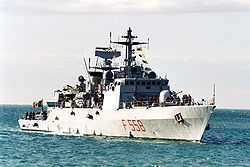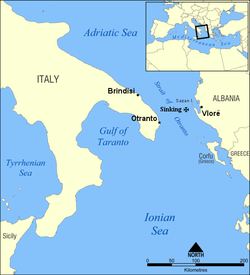Tragedy of Otranto
|
Location of the sinking in the Strait of Otranto | |
| Event | Sinking of Albanian motorboat Kateri i Rades |
|---|---|
| Cause | Collision with Italian Navy corvette Sibilia |
| Place | Strait of Otranto, 35 miles (56 km) from the Italian coast |
| Deaths | 83 people |
| Time | 28 March 1997; 4:30 PM (UTC-3:30 PM) |
| On board | 142 people |
The Tragedy of Otranto took place on 28 March 1997 when the Albanian ship Kateri i Radës sank in a collision with the Italian naval vessel Sibilia in the Strait of Otranto and 83 Albanians lost their lives. The emigrants had been part of a large migration of Albanians to Italy following the Lottery Uprising in Albania, a popular uprising that took place after the collapse of several investment pyramid schemes. In order to prevent the unauthorized entry of illegals migrants into Italy, the Italian Navy set up a procedure to board Albanian vessels whenever encountered, implementing a de facto blockade.
In proceeding to carry out a boarding, the Italian vessel Sibilia collided with Kateri i Radës and capsized it, resulting in the Albanian deaths. The captains of both ships were held responsible for "shipwreck and multiple manslaughter".[1] The event raised questions over the extent of power that a state may exercise to protect itself from unauthorized entry. Arguments were presented that a state must limit coercive actions that are disproportionate to the risk of unauthorized entry. The United Nations High Commissioner for Refugees criticized the Italian blockade as illegal since it had been established solely through an intergovernmental agreement with Albania.
Background
After the fall of communism in Albania in 1990, thousands of Albanians travelled by ship or boat to Italy. One of the early migrations involved the landing of 640 Albanians in Otranto on the south-eastern tip of the Italian peninsula, and received help from the local population. Italian civil servants were soon sent to Otranto to observe the situation. This openness to the Albanians resulted in 20,000 more Albanians landing in Brindisi after a few days, 17,000 landing in Bari in August 1991, and 15,000 in early March 1997. Much of the Italian media portrayed the situation as "barbarians" invading Italian soil.[2] As a consequence of the Gulf War, Italian opinion-makers voiced concerns regarding the alleged "Islamic danger"[3] of the migration. Others saw a connection between the Ottoman invasion of Otranto (1480–1481) across the 40 miles (64 km) wide Strait of Otranto and contemporary migration.[3]
In 1997, a crisis erupted in Albania after the collapse of several investment pyramid schemes which resulted in social deterioration in the country in the beginning of March. An imposition of a curfew and a state of emergency on 2 March provoked a popular rebellion, causing concern in Italy which feared an expansion of the conflict into the Balkan area and its exposure to the risk of massive migration flows. Albanian migration to Italy reached its maximum intensity in the latter half of March, bringing great pressure to Italian accommodation centers and provoking a strong reaction in Italian public opinion.[4] Italy had been operating under a bilateral agreement with Albania to board Albanian vessels whenever encountered[5] starting on 3 April 1997 and Albanian would-be migrants going to Italy would be sent back to Albania, in exchange for Italian financial, police, and humanitarian assistance to the country. A military Operation White Flags was established in the international waters of the Strait and implemented a de facto naval blockade.[6]
Sinking

The incident happened on 28 March 1997 in the Strait of Otranto when the Italian Navy vessel Sibilia collided with the Albanian ship Kateri i Radës which had left from the Albanian port city of Vlorë with 142 people on board.[7][8] The Sibilla sought to stop and inspect the ship suspected of containing irregular migrants. The vessel instead ended up colliding with the ship and sinking it.[5] According to Italian authorities, there was no intention to cause the collision. The Zefiro first approached and identified the Kateri i Radës as a motorboat with approximately 30 civilians on board. The motorboat continued toward Italy even though a stop order issued by the Zefiro.[1] This happened around 4:30 PM, near the Albanian island Sazan.[8] Sibilia then took over the operation and during its maneuvers, the Italian ship caused the Kateri i Radës to turn which resulted in subsequent deaths.[1] After the Albanian ship was capsized, the Sibilia allegedly left and came back approximately 20 minutes later.[8] The bodies of at least 52 who lost their lives[1] were recovered.[7] The total number of dead is assumed to be 83.[5] The survivors were taken to the Apulian port of Brindisi, where they arrived at 2:45 AM. They were then put on a bus, and taken to an immigration center to be identified.[9] On 29 and 30 March 1997, news of the disaster made it to the first page of major Italian newspapers, relating the sense of gravity of the incident, which reported it as either a collision or a ramming.[6]
Legal proceedings
The accident raised questions about the extent of power that the state may use to protect from unauthorized entry. Although undisputed that the sinking was unintentional, controversy exists over whether it was a result of dangerous maneuvering, which was disproportionate in relation to the stopping of the ship. Authors argue that there is an obligation for the state to limit coercive actions which are disproportionate to the risk of intrusion.[1] The United Nations High Commissioner for Refugees criticized the Italian blockade as "illegal"[6] since Italy established it only through a bilateral, intergovernmental agreement with Albania.[6]
The Xhavara et. al v. Italy and Albania case was held to be inadmissible because of non-exhaustible national remedies.[5] The European Court of Human Rights, which held the case, assumed jurisdiction relying on the bilateral agreement between Albania and Italy.[10] The ship was recovered 35 miles (56 km) from the Italian coast, no more than 10 miles (16 km) to 15 miles (24 km) from the Albanian coast within Albanian territorial waters.[9] The court held Italy responsible for the incident since it was considered to have exercised jurisdiction. Italy was also held responsible for holding an investigation of the deaths, a requirement which was considered to have been fulfilled by the public manslaughter proceedings held against the captain of the Italian vessel.[5] By the end of eight years of proceedings, the Court of Brindisi convicted the Italian and Albanian captains together of "shipwreck and multiple manslaughter"[1] with the first to three years in prison and the second to four. Responsibility for the "accident"[1] was attributed to both and was relegated to the individual level.[1] The larger chain of command, legal framework, discourses, and established practices which resulted in the sinking have not been judicially investigated.[6]
Remembrance
The tragedy became part of the Albanian folk song repertoire relating to the migration of Albanians abroad. The leading figures of this practice were local intellectuals called rapsods related the mythistory of kurbet before World War II with the migration. They make use of metaphors and performance devices taken from oral folk poetry and death laments which react on the migrations to fix them in the memory of the community. This became a tool for responding to the loss of life for the tragedy of Otranto and other tragic events.[11]
Parts of Kateri i Radës were transported to a concrete platform in the port of Otranto as a monument to the tragedy. The project cost €150 thousand and was entrusted to the Greek sculptor Costas Varotsos. Before the project, what was left of the ship lay in a corner of the port of Brindisi.[12] The project was titled L'Approdo. Opera all'Umanità Migrante (The Landing. A work dedicated to Migrating Humanity).[13] Photographers Arta Ngucaj and Arben Beqiraj published photographs of the ship on the Albanian-Italian newspaper Shqiptari i Italisë.[14] The families of the dead requested for the relics of Kateri i Radës to be placed in Albania after Italian media reported that it was to be used as a monument.[15]
See also
References
- ↑ 1.0 1.1 1.2 1.3 1.4 1.5 1.6 1.7 Ryan, Bernard; Mitsilegas, Valsamis (2010). Extraterritorial immigration control: legal challenges. BRILL. p. 294. ISBN 90-04-17233-5.
- ↑ Guild, Elspeth; Minderhoud, Paul (2006). Immigration and criminal law in the European Union: the legal measures and social consequences of criminal law in member states on trafficking and smuggling in human beings. Immigration and asylum law and policy in Europe 9. Martinus Nijhoff Publishers. p. 182. ISBN 90-04-15064-1.
- ↑ 3.0 3.1 Albahari, Maurizio (June 2006), Death and the Moral State: Making Borders and Sovereignty at the Southern Edges of Europe (PDF), Center for Comparative Immigration Studies, University of California, San Diego, p. 5, retrieved 26 January 2010
- ↑ Ryan, Bernard; Mitsilegas, Valsamis (2010). Extraterritorial immigration control: legal challenges. BRILL. p. 293. ISBN 90-04-17233-5.
- ↑ 5.0 5.1 5.2 5.3 5.4 Gibney, Mark; Skogly, Sigrun (2010). Universal human rights and extraterritorial obligations. University of Pennsylvania Press. p. 72. ISBN 0-8122-4215-7.
- ↑ 6.0 6.1 6.2 6.3 6.4 Albahari, Maurizio (June 2006), Death and the Moral State: Making Borders and Sovereignty at the Southern Edges of Europe (PDF), Center for Comparative Immigration Studies, University of California, San Diego, p. 8, retrieved 26 January 2010
- ↑ 7.0 7.1 Vulpio, Carlo (18 March 1998). "Strage di Otranto, indagati due ammiragli". Corriere della Sera. Retrieved 25 January 2012.
- ↑ 8.0 8.1 8.2 Albahari, Maurizio (June 2006), Death and the Moral State: Making Borders and Sovereignty at the Southern Edges of Europe (PDF), Center for Comparative Immigration Studies, University of California, San Diego, p. 6, retrieved 26 January 2010
- ↑ 9.0 9.1 Albahari, Maurizio (June 2006), Death and the Moral State: Making Borders and Sovereignty at the Southern Edges of Europe (PDF), Center for Comparative Immigration Studies, University of California, San Diego, p. 7, retrieved 26 January 2010
- ↑ Geiss, Robin; Petrig, Anna (2011). Piracy and armed robbery at sea: the legal framework for counter-piracy operations in Somalia and the Gulf of Aden. Oxford University Press. p. 114. ISBN 0-19-960952-7.
- ↑ Pistrick, Eckehard (2010), Singing back the kurbetlli – Responses to migration in Albanian folk culture as a culturally innovative practice (PDF), Anthropological Notebooks 16, Slovene Anthropological Society, p. 29, ISSN 1408-032X, retrieved 25 January 2012
- ↑ "Monument për tragjedinë e Otrantos". Koha Ditore. 15 December 2011. Retrieved 19 February 2012.
- ↑ Biçoku, Keti (30 January 2012). "L'ultimo approdo della Katër i Radës". Shqiptari i Italisë. Retrieved 19 February 2012.
- ↑ "Fotot ekskluzive: Katër i Radës copëtohet për t'u bërë monument". Shqiptari i Italisë. 14 December 2011. Retrieved 19 February 2012.
- ↑ "Tragjedia e Otrantos, familjarët: 'Kateri i Radës' të kthehet në Shqipëri". Balkanweb. 13 December 2011. Retrieved 25 January 2012.
Coordinates: 40°13′10″N 18°48′32″E / 40.21944°N 18.80889°E
